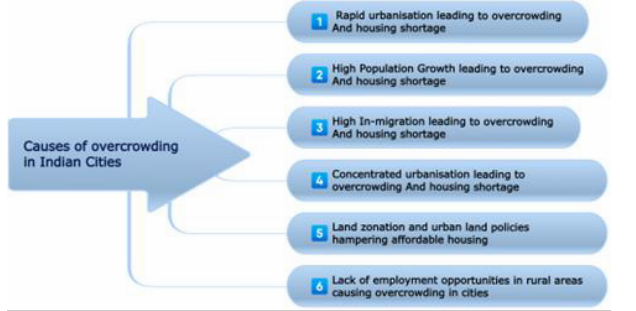
The issue of overcrowding in Indian cities has become a pressing concern, leading to a chronic problem of housing shortages. As urbanization accelerates and the population continues to grow, the demand for housing has surged, outpacing the rate at which new residential spaces are being developed. This imbalance has resulted in densely populated urban areas, exacerbating the scarcity of affordable and adequate housing. Examples of this crisis are evident in major metropolitan centers such as Mumbai, Delhi, and Kolkata, where skyrocketing population figures have strained the existing housing infrastructure. The struggle for space is reflected in the proliferation of slums and informal settlements, where a substantial portion of the urban population resides in substandard conditions due to the shortage of affordable and well-constructed housing. The repercussions of this chronic housing shortage extend beyond mere accommodation challenges, impacting overall living standards, public health, and the socio-economic fabric of these burgeoning cities. Addressing this issue requires comprehensive planning, innovative solutions, and sustainable urban development strategies.
Contents
- 1 Answer
- 1.1 Causes of Overcrowding in Indian Cities Leading to Chronic Shortage of Housing
- 1.1.1 Rapid Urbanisation leading to overcrowding and housing shortage
- 1.1.2 High Population Growth leads to overcrowding and a housing shortage
- 1.1.3 High In-migration into cities leading to overcrowding and housing shortage
- 1.1.4 Concentrated Urbanisation Leading to Overcrowding and Housing Shortage
- 1.1.5 Land Zonation and Urban Land Policies Hampering Affordable Housing
- 1.1.6 Lack of employment opportunities in rural areas Causing Overcrowding in Cities
- 1.2 Solutions
- 1.1 Causes of Overcrowding in Indian Cities Leading to Chronic Shortage of Housing
- 2 In case you still have your doubts, contact us on 9811333901.
Answer
According to a 2021 study by the Ministry of Housing and Urban Affairs (MHUA), the estimated housing shortage in Indian cities is 18.78 million units,95% of this shortage is in the low-income and middle-income segments, one of the main reasons for this shortage is overcrowding in Indian cities.
Causes of Overcrowding in Indian Cities Leading to Chronic Shortage of Housing

Rapid Urbanisation leading to overcrowding and housing shortage
- 32% urbanization (Census 2011),160 million people living in just 53 metropolitans(Census 2011)
- The increase in the demand for housing has not been matched by an increase in the supply of housing
- The cost of housing in Indian cities is high, making it difficult for people to afford to buy or rent a home, leading to overcrowding, and people forced to live in cramped and unsanitary conditions.
High Population Growth leads to overcrowding and a housing shortage
- Population Growth rate was 1% in 2022,1.5 cr people being added every year to the population pool, total land area is constant, thus problems of overcrowding.
High In-migration into cities leading to overcrowding and housing shortage
- High In-migration mainly due to lack of economic opportunities in rural areas
- Total number of rural-to-urban migrants in India is 69.6 million(Census 2011),mostly concentrated in a few metropolitan centres.
- Cities are seen as a promise for better life quality even when this is far from reality.(Concept of Place by Yi-Fu-Tuan)
Concentrated Urbanisation Leading to Overcrowding and Housing Shortage
- India’s urbanisation is said to top heavy with just 53 metropolitan cities,
- Problems of overcrowding, congestion, proliferation of slums and squatter settlements deteriorate the overall quality of life in cities.


Land Zonation and Urban Land Policies Hampering Affordable Housing
- Stringent land use regulations and zoning laws in some cities can hinder the construction of affordable housing, regulations may limit the height and density of buildings, reducing the number of housing units that can be built on available land.

Lack of employment opportunities in rural areas Causing Overcrowding in Cities
- Lack of job opportunities in rural areas acts as a push factor driving people out(Lee’s migration theory)
- Additionally, there is a lack of intervening opportunities (Stouffer’s Theory of Intervening Opportunities)in Tier2 and Tier3 cities, bypassing of stepped migration(Ravenstein’s law of Migration).
Solutions
- The government can increase the supply of affordable housing by providing subsidies to developers, reducing the cost of land, and simplifying the regulatory environment.
- The government can also build affordable housing units directly.
- The government can make it easier for people to access finance to buy or rent a home by providing subsidies for home loans increasing the availability of mortgage loans, promoting microfinance institutions that provide loans to low-income borrowers
- Developing satellite cities and discouraging people from migrating to major cities
- Promote rural development to make rural areas more attractive to people,by improving infrastructure, providing job opportunities, and increasing access to education and healthcare.
Pradhan Mantri Awas Yojana (PMAY), National Housing Bank (NHB), and Smart Cities Mission are the steps by the government in the right direction. These will help in achieving SDG14(Sustainable Cities) and making cities a decent place to live for all.
In case you still have your doubts, contact us on 9811333901.
For UPSC Prelims Resources, Click here
For Daily Updates and Study Material:
Join our Telegram Channel – Edukemy for IAS
- 1. Learn through Videos – here
- 2. Be Exam Ready by Practicing Daily MCQs – here
- 3. Daily Newsletter – Get all your Current Affairs Covered – here
- 4. Mains Answer Writing Practice – here

